Making Bulgogi With Sliced Roast Beef
Bulgogi is a classic Korean BBQ beef dish that everyone loves. This authentic beef bulgogi recipe uses thin slices of beef with a flavorful marinade. It cooks fast and your meat will be so tender and juicy. Treat yourself to one of Korea's most popular dishes with this easy recipe. It's a best!
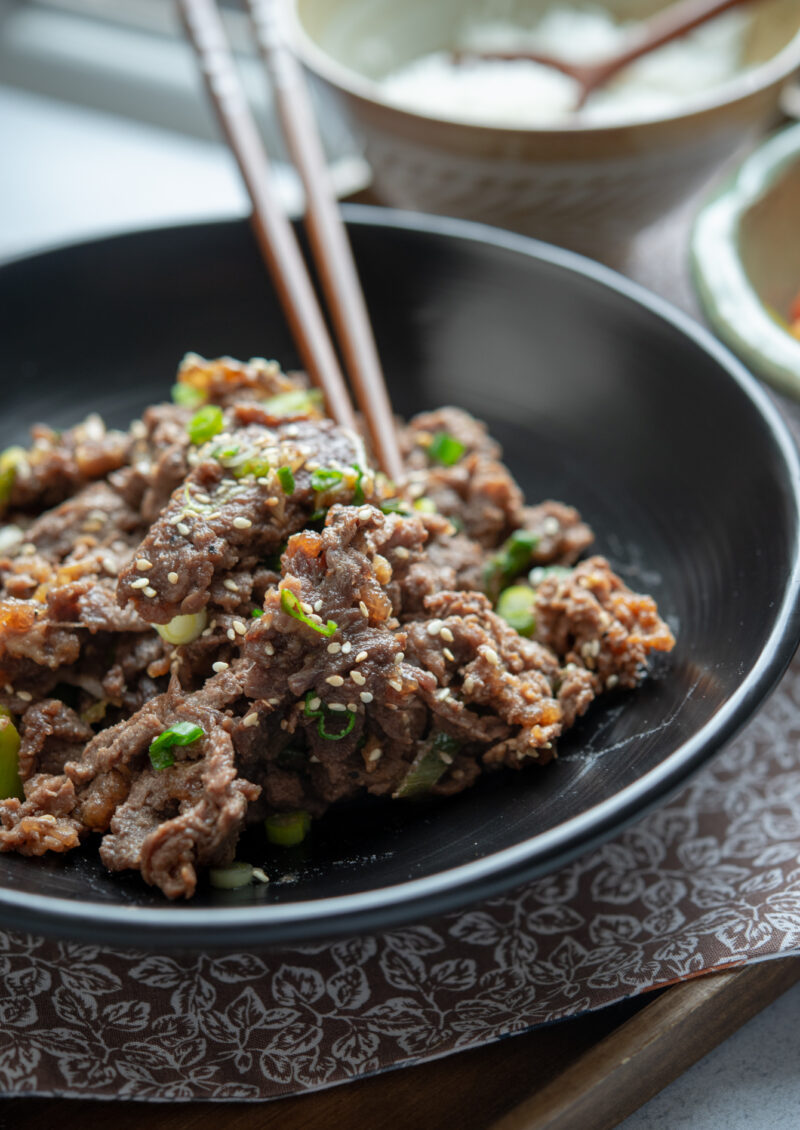
"This was divine…..I think your special sauce and not adding the veggies right away helped make this one of the most beautiful bulgogi ever!"
michel
As a native Korean, I have eaten beef bulgogi all my life. When the thinly sliced beef marinated in a flavorful bulgogi sauce hits a very hot skillet or griddle on an open flame, it reminds you the smell of your favorite Korean BBQ restaurant. I have never met anyone who would not like Korean beef.
Who can refuse the tender flavorful beef in a savory sauce? It is a killer dish to serve with rice. Whether you serve it as a signature main dish or as a simple Korean beef bowl, it's all Korean heaven!
What is Bulgogi?
bul = fire or flame
gogi = meat
It literally translates into meat cooked over fire – the title, Korean BBQ, comes from that. In ancient days, Koreans cooked their meat directly over the flame in their outdoor kitchen. They grilled the meat by putting a layer of thinly sliced meat between two mesh screens and holding it over the fire. Grilling this way incorporates the smoky flavor from the BBQ and yields a super delicious result.
However, in modern-day Korean home cooking, people have adapted to cooking bulgogi in a skillet instead of barbecuing outdoors (not every household has an outdoor kitchen).
There are many types of Korean bulgogi recipes with different meat choices in Korean cuisine. Chicken bulgogi and pork bulgogi are two other famous dishes. It is the beef, however, that is the pinnacle of all Korean bulgogi recipes. It is a classic that you should not miss.
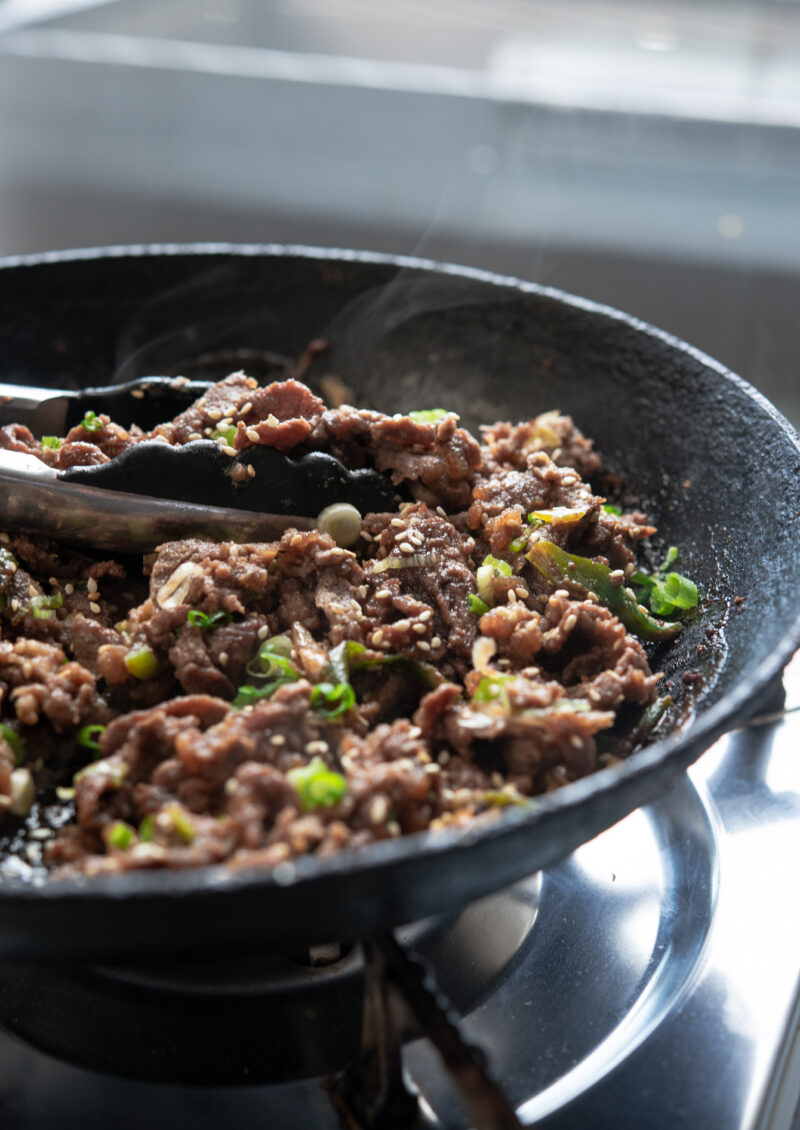
Types of Beef Bulgogi
Not all Korean bulgogi are created the same. The method varies one region to another in Korea.
1. Classic Bulgogi:
Thinly sliced beef is marinated in a flavorful sauce. Traditionally, bulgogi requires a few hours of marinating time to tenderize the beef and to allow the beef to soak up all the flavor from the marinade. Some like to add mushrooms and vegetables – such as carrot or pepper – along with the beef. I am not a huge fan of that. I like my bulgogi to be truly beef only (with a little bit of green onion or leek for the flavor).
2. Seoul-style bulgogi:
Unlike the Korean beef that most people know, Seoul-style bulgogi uses broth made with sea kelp stock in the marinade. The beef is cooked on a special dome-shaped pan with holes and a flat bottom. The dome shape allows the meat drippings and broth to flow down. The broth is so tasty to drizzle over rice. People often cook Korean noodles (dangmyun), mushroom, and vegetables together with this Seoul style Korean beef. I shared my recipe in my cookbook, Korean Cooking Favorites, so check it out!
3. Crispy Bulgogi:
Unlike Seoul-style, crispy bulgogi doesn't yield any juicy broth. It has a crispy texture on the outside. This cooking method is common in South Korea's Jeolla Province. Check my Crispy Korean Beef to get the recipe.
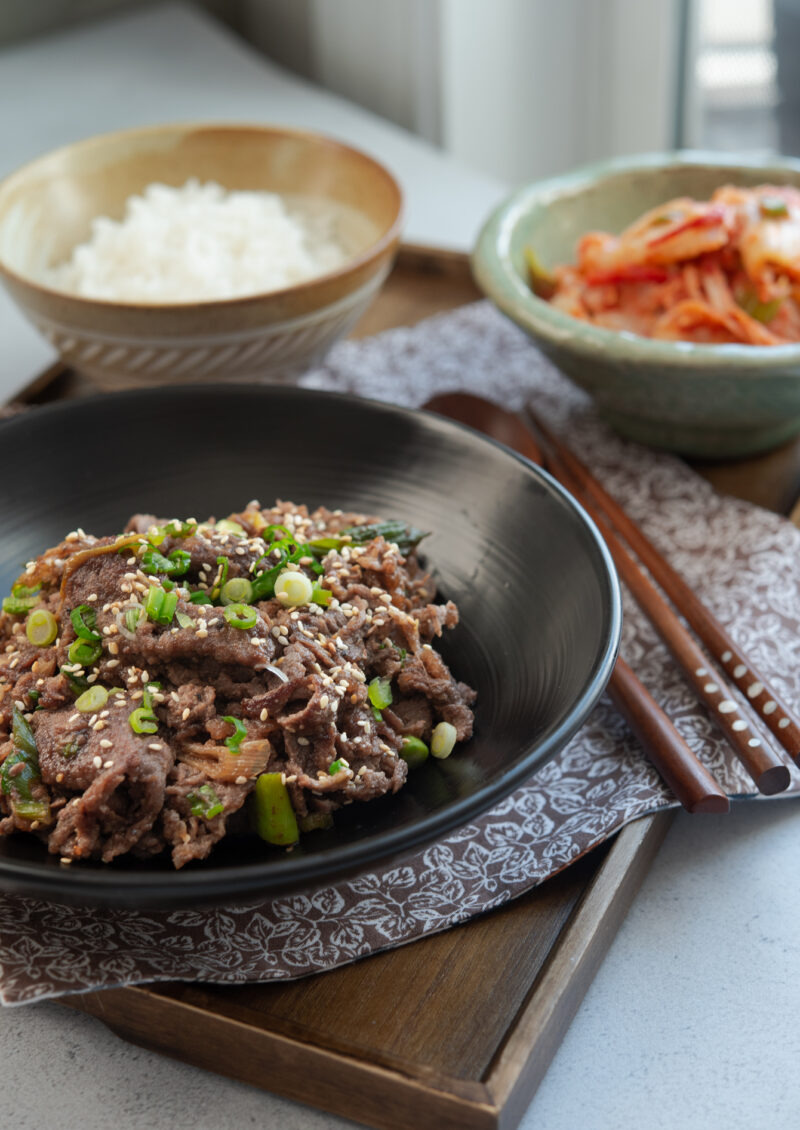
Ingredients for Homemade Beef Bulgogi Sauce
It is easy to make homemade Korean beef sauce to use as a marinade, and it will taste so much better than the ones you buy at the store. You'll need the following marinade ingredients:
- Asian pear (preferably Korean pear) – It adds a pear flavor to the sauce and tenderizes the meat.
- kiwi – This highly acidic fruit tenderizes the beef very fast, so use a small amount. If you intend to marinate the beef longer than 4 hours, use half the amount in the recipe (so 1/4 kiwi).
- onion
- garlic
- soy sauce
- Korean tuna sauce or Korean soup soy sauce – It adds umami flavor to the beef and deepens the taste. You can leave it out but I highly recommend adding it. You will love the outcome.
- rice wine – optional
- brown sugar
- pepper – Use plenty. Trust me, it tastes better.
- sesame oil
How to make Beef Bulgogi
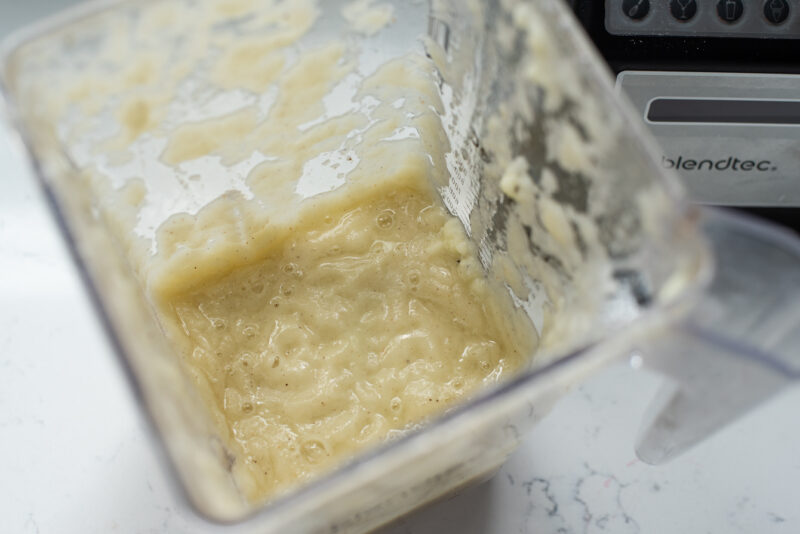
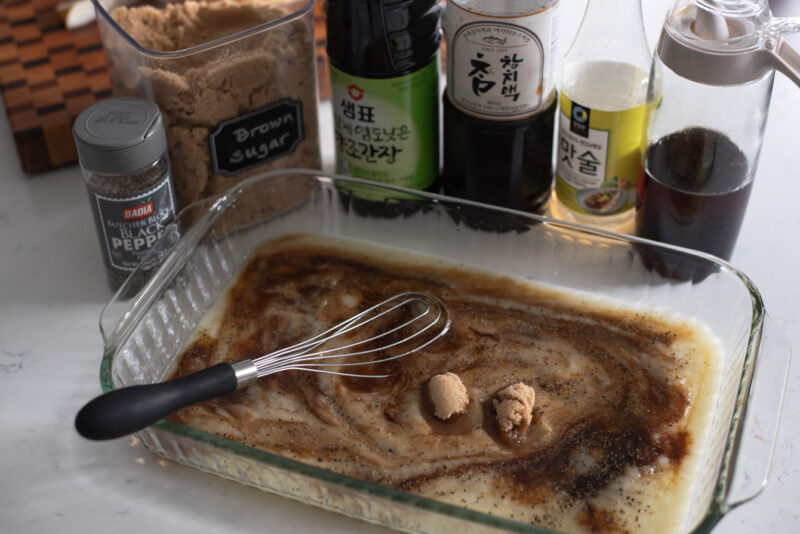
Step 1. Make Korean beef bulgogi sauce (marinade)
- Put diced pear, kiwi, onion and garlic in a blender and process until very smooth.
- Pour the onion/fruit puree into a large shallow pan – a 9×13-inch Pyrex baking pan (with a lid) is perfect for this.
- Add soy sauce, tuna sauce (or soup soy sauce), rice wine, Korean plum extract (if using), brown sugar, pepper and sesame oil; mix well.
- You can make this marinade sauce ahead of time and keep it in the refrigerator for up to 1 week.
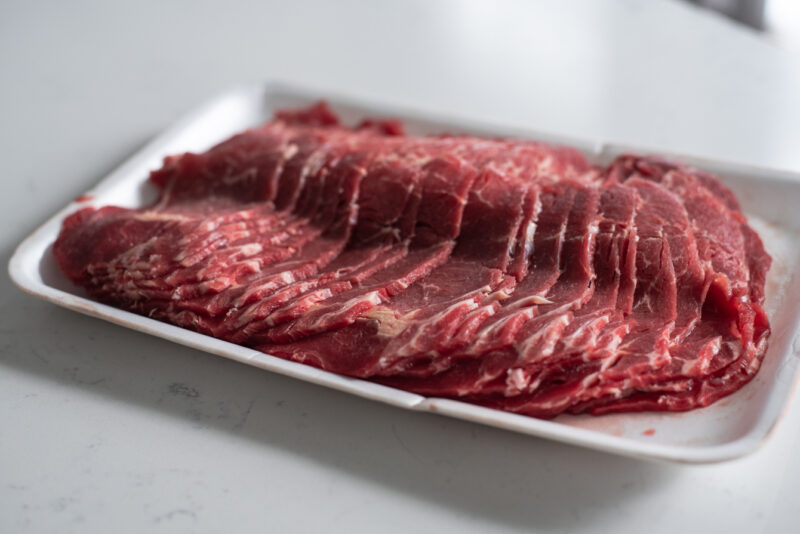
Step 2. Get a thinly sliced beef
- Thinly sliced beef sirloin, ribeye or flank steak are ideal cut of beef. You can purchase it in any Korean grocery. They usually come in a frozen package. Make sure to thaw it ahead of time.
- Alternatively, freeze a chunk of beef sirloin for 20 minutes to slightly firm up. Then slice it very thinly against the meat grain.
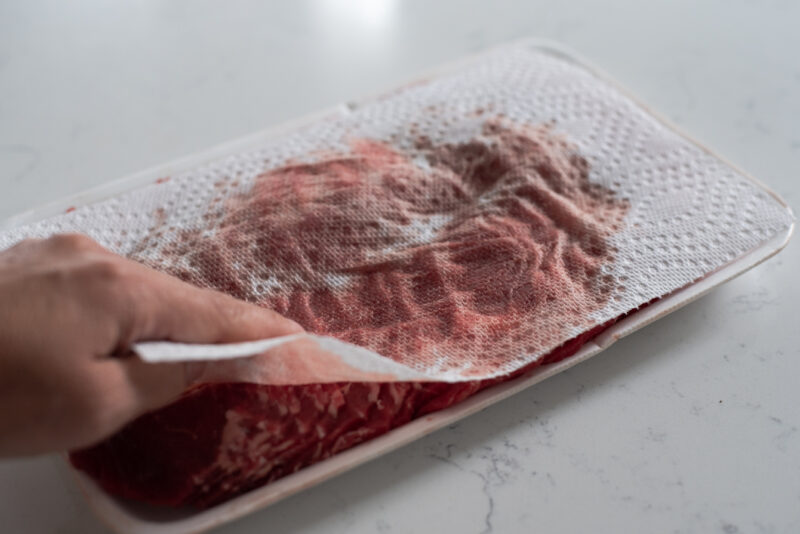
Step 3. This is an optional but recommended.
- Dab the beef with a paper towel to remove the extra red myoglobin from the surface. It helps get rid of unpleasant gamy smell if the beef was frozen too long.
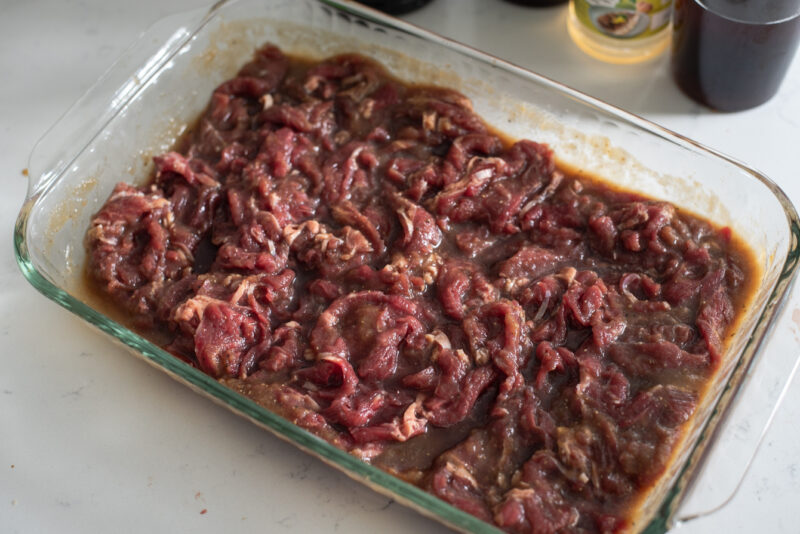
Step 4. Toss beef in a marinade.
- Separate the beef slices and add them to the marinade sauce. Toss gently by hand to combine everything with a slight massaging motion. Cover and marinate for at least 1 hour or up to overnight.
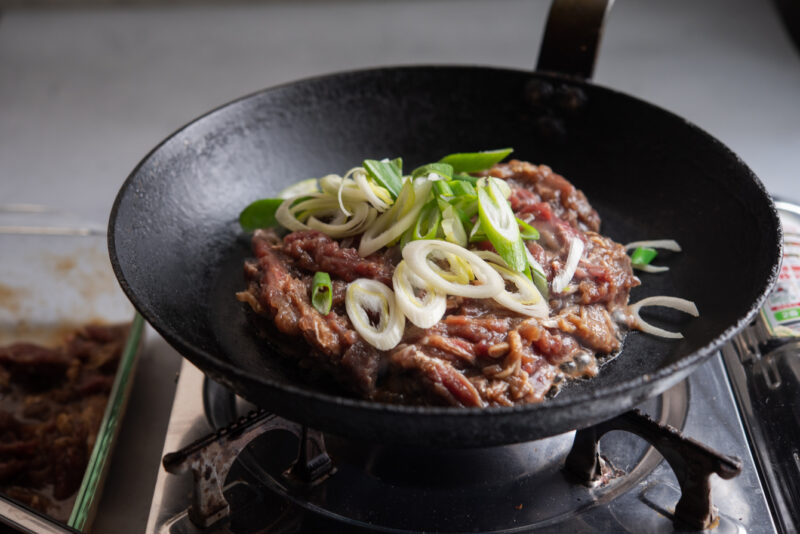
Step 5. Cook marinated beef in a very hot skillet
- Heat a skillet very hot over high heat. Do Not Add any vegetable oil! Add the beef. You can add sliced Asian leek on top as I did, or onion or green onion.
- You can also add thinly sliced carrot, or pepper if you want it to be more wholesome, but then, it won't be a classic bulgogi.
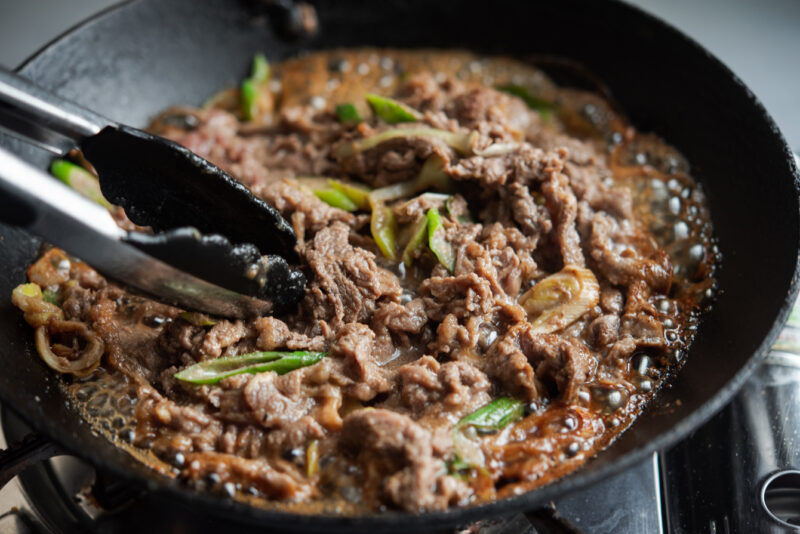
Step 6. Cook beef in its own marinade sauce.
- The beef should sizzle as soon as it touches the hot skillet. Let the meat cook in its own juice. Toss the meat around to cook evenly and thoroughly, about 2-3 minutes. It should cook very quickly.
- Sprinkle with sesame seeds and green onion to garnish.
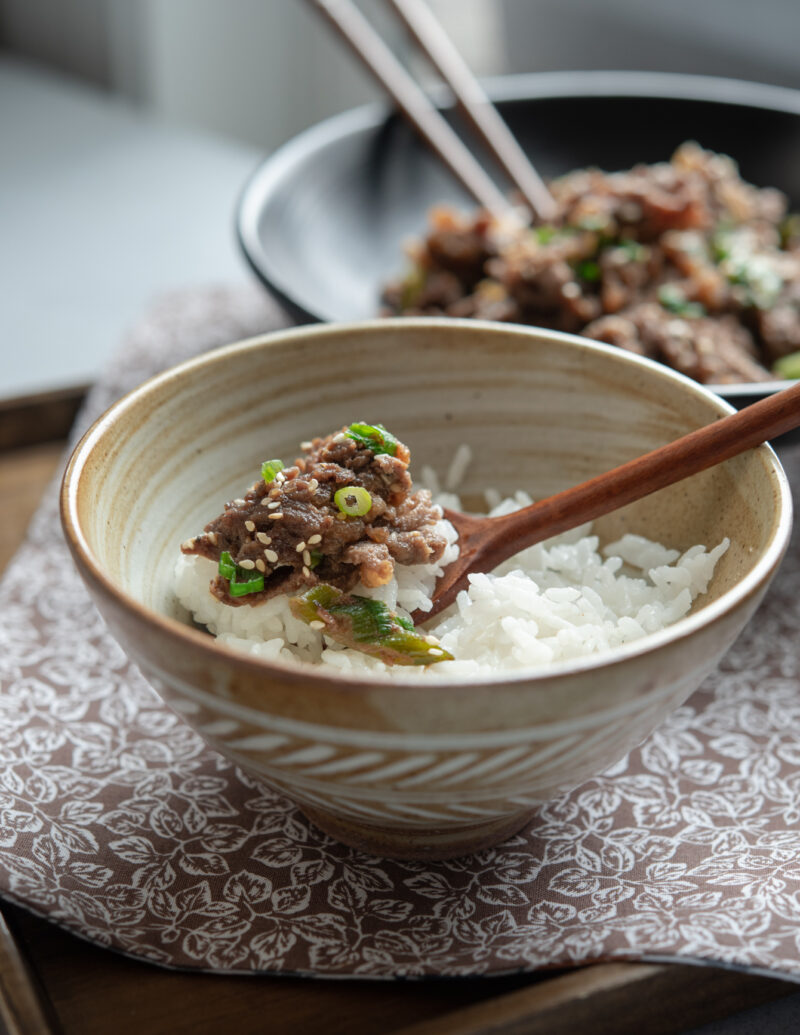
What to serve with Beef Bulgogi?
If you like it as a simple one bowl meal, as a Korean beef bulgogi bowl, top it on the white rice and kimchi (or other vegetable side dish) on the side all together in a bowl.
Want to fancy things up? Try it with lettuce leaves and ssamjang to make wraps. Doenjang jjigae on the side will make the whole meal very authentically Korean.
Don't forget to serve a few simple Korean side dishes alongside. Here are my suggestions:
- How To Make Best Cucumber Kimchi (Oi-sobagi)
- Broccoli Rabe Salad with Soybean Paste
- Korean Spicy Cucumber Salad (Oi Muchim)
- Korean Spinach Side Dish (Sigeumchi Namul)
- Bean sprout salad

Beef Bulgogi (Korean BBQ Beef)
Bulgogi is a classic Korean BBQ beef made with a flavorful marinade. This authentic beef bulgogi recipe cooks fast and so tender and juicy. No oil is needed to cook. It's the best!
- 2 lb beef sirloin or rib eye , thinly sliced, about 1/8-inch thick
- 1 Asian leek or 3 green onion, sliced
To marinate beef
-
To make bulgogi marinade, put pear, kiwi, onion, and garlic in a blender and process until very smooth.
-
Pour the onion/fruit puree into a large shallow pan – a 9×13-inch pyrex baking pan (with lid) is perfect for this. Add soy sauce, Koran soup soy sauce, Korean plum extract (if using), brown sugar, rice wine, pepper and sesame oil; mix well. You can make this marinade sauce ahead of time and keep it in the refrigerator for up to 1 week.
-
Dab the beef with a paper towel to remove extra myoglobin from the surface. Separate the beef slices and add them to the marinade sauce. Toss gently by hand to combine everything with a slight massaging motion. Cover and marinate for at least 1 hour or up to overnight.
To cook bulgogi
-
Heat a skillet very hot over high heat. Do not add any oil! Add the beef. You can add sliced Asian leek on top, or green onion. You can also add thinly sliced carrot, or pepper if you want it to be more wholesome.
-
The beef should sizzle as soon as it touches the hot skillet. Let the meat cook in its own juice. Toss the meat around to cook evenly and thoroughly, about 2-3 minutes. It should cook very quickly. Sprinkle with sesame seeds and green onion to garnish. Serve warm with rice and a vegetable side dish.
Kiwi: This highly acidic fruit tenderizes the beef very fast, so use a small amount. If you intend to marinate the beef longer than 4 hours, use 1/4 kiwi. If marinating less then 4 hours, use 1/2 kiwi.
Calories: 303 kcal , Carbohydrates: 11 g , Protein: 25 g , Fat: 18 g , Saturated Fat: 7 g , Polyunsaturated Fat: 2 g , Monounsaturated Fat: 8 g , Cholesterol: 69 mg , Sodium: 850 mg , Potassium: 404 mg , Fiber: 1 g , Sugar: 7 g , Vitamin A: 211 IU , Vitamin C: 5 mg , Calcium: 33 mg , Iron: 3 mg
Tag @beyondkimchee on Instagram. I love to see your masterpiece.
This recipe was originally posted in November 2010. I've updated the recipe with minor changes, new photos, and more information.
Source: https://www.beyondkimchee.com/bulgogi/
0 Response to "Making Bulgogi With Sliced Roast Beef"
Post a Comment